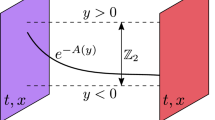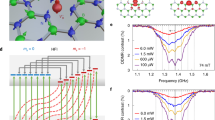Abstract
IT is known that the 2-component spinors introduced by Van der Waerden must be completed to 4-component quantities if linear transformation of their components by the complete Lorentz group including reflections is required. These quantities, often called ‘Dirac wave-functions’, will be called here ‘four-spinors’ or ‘undors* of the first rank’. Defining the reflection in the right way1, it is possible to join to every four-spinor ψ another four-spinor2 ψ£, the components of which are linear combinations of those of ψ*. This ψ£ is called the charge-conjugated3 of ψ. For if ψ is a solution of the Dirac equation for a positive particle, then ψ£ is a solution of the Dirac equation for a negative paricle: vice versa ( ψ££ = ψ). Four-spinors, which are equal to their own charge-conjugated, we may call neutrinors. These quantities, which are equivalent to a two-spinor together with its complex conjugated, are not only useful in the so-called neutrino theory of light, but also Majorana's theory of neutrons4 may be summarized by stating that the quantized fourspinor of a neutral particle is neutrinor.
This is a preview of subscription content, access via your institution
Access options
Subscribe to this journal
Receive 51 print issues and online access
$199.00 per year
only $3.90 per issue
Buy this article
- Purchase on SpringerLink
- Instant access to full article PDF
Prices may be subject to local taxes which are calculated during checkout
Similar content being viewed by others
References
Racah, Nuov. Cim., 14, 322 (1937).
Pauli, Ann. Inst. H. Poincaré, 6, 130 1936).
Kramers, Proc. Roy. Acad. Amsterdam, 40, 814 (1937).
Majorana, Nuov. Chim., 14, 171 (1937).
Kemmer, Proc. Roy. Soc., A, 166, 127 (1938).
Compare De Broglie, "Actual. Scient. Indust.", No. 181 (1934) and No. 411 (1936).
Yukawa, Proc. Phys. Math. Soc. Japan, 20, 319 and 720 (1938).
Bhabha, Proc. Roy. Soc., A, 166, 501 (1938).
Fröhlich, Heitler and Kemmer, Proc. Roy. Soc., A, 166, 154 (1938).
Heisenberg and Pauli, Z. Phys., 56, 1 (1929).
Rosenfeld, Ann. Inst. H. Poincaré, 2, 25 (1932).
Author information
Authors and Affiliations
Rights and permissions
About this article
Cite this article
BELINFANTE, F. A New Form of the Baryteron Equation and Some Related Questions. Nature 143, 201 (1939). https://doi.org/10.1038/143201a0
Issue date:
DOI: https://doi.org/10.1038/143201a0
This article is cited by
-
A terminological history of early elementary particle physics
Archive for History of Exact Sciences (2023)



